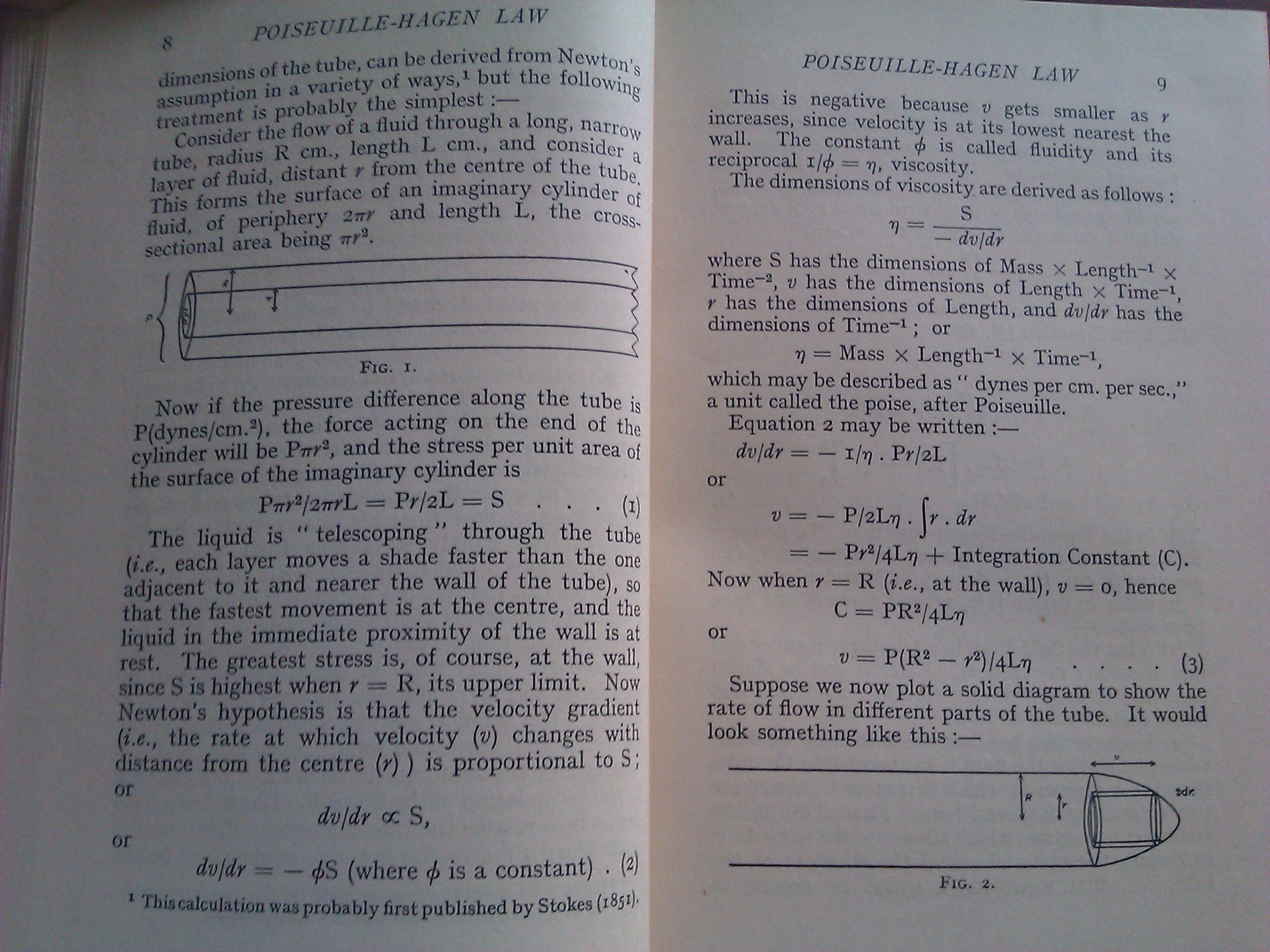82553 str (136)

| POI SE UIL LE-HA GEN LAW
dimensions of the tubę, can be derived from Newton s assumption in a variety of ways,1 but the following treatment is probably the simplest :—
Consider tlie li o w of a lluid through a long, narrow tubę, radius R cm,, length L cm., and consider a layer of fluid, distant r from tłie centre of the tubę. This forms the surface of an imaginary cylinder of lluid, of periphery z-nr and length L, the cross-sectional area being |rra.

Fig. i.
Now if the pressure difference along the tubę is P(dynes/cm.a), the force acting on the end of the cylinder will be P7rr%, and the stress per unit area of the surface of the imaginary cylinder is
PTrra/2urŁ = Pr/2h = S . . . ' (i) The liąuid is 1 telescoping | through the tubę {i.e., each layer moves a shade faster than the one adjacent to it and nearer the wali of the tubę), so that the fastest movement is at the centre, and the liquid in the immediate proximity of the wali is at rest. The greatest stress is, of course, at the wali, sińce S is highcst when r — R, its upper limit. Now Newton's hypothesis is that the yelocity gradient [i.e., the ratę at which yelocity (v) changes with distance from Ihc centre (r)) is proportional toS; or
dvjdr cc S,
or
dvjdr ~ — <f)i (where i is a constant) . (2)
I This calcuJalion was probably first published by Stokes (i8jx)<
This is negative because v gets smaller as r increases, sińce velocity is at its lowest nearest the wali. The constant <j> is called fluidity and its reciprocal im = M viscosity.
The dimensions of viscosity. are derived as follows i S
— dvfdr
where S has the dimensions of Mass x Length-1 x Time-2, | has the dimensions of Length x Time-1, r has the dimensions of Length, and dvjdr has the dimensions of Time-1; or
S = Mass X Length-1 x Time-1, which may be described as | dynes per cm. per sec.,” a unit called the poise, after Poiseuille.
Eąuation 2 may be written :— dv/dr — — i/rj. PrjzŁ OT
v — — P/2L7J. jy . dr
— — ~Pr2lĄLr) + Integration Constant (C). Now when r — R [i.e., at the wali), v = o, hence
C = PR2/4Lt, or
I— P(R2 — f2)/4Lrj • • • • (3) Suppose we now plot a solid diagram to show the ratę of flow in different parts of the tubę. It would look something like this :—

Fig. 2.
Wyszukiwarka
Podobne podstrony:
Seniester II Se m ester Subject Types Course Codę Title of the
str 2 136 Ha ulen 11 hitr przetwarzania wiedzy w opowieść , zamykania doświadczenia człowieka w for
Le 0’Suva est le grand tempie et est entoure (Pun parć public. Font pas se trome le bazar generał,
page0099 97 nation.” Mais Moi se conjura le Seigneur son Dieu, en disant: „Seigneur, pourquoi votre
page0181 179 C’est pourquoi il se contrefit le yisage, se laissa tom-ber entre les mains des Philis
Roland devint ministre de Fintę- . dc sa femme et se suicide le rieur. Mais Manon Roland est 11 nove
str 2 136 liaydeu WUitr przetwarzania wiedzy w opowieść , zamykania doświadczenia człowieka w formi
68 (188) str. 136 • TO TAKIE PROSTE - Anna Opala Życie jest nie do pomyślenia bez śmierci i być w zg
Str 136 Dane: F = 0,01 m2, L = 0,1 m, H = 0,6 m. kx = 1,9- 10“5m/s, *2 = 4,8 ■ 10 4m/s, k2 = 1,21 ■
str 136 137 W 1895 roku wstępuje do Związku Zagranicznego Socjalistów Polskich. Kontaktuje się z mło
str 136 137 sensownego planu walki z nieprzyjacielem. Wyczerpany licznymi trudnościami, po otrzymani
więcej podobnych podstron